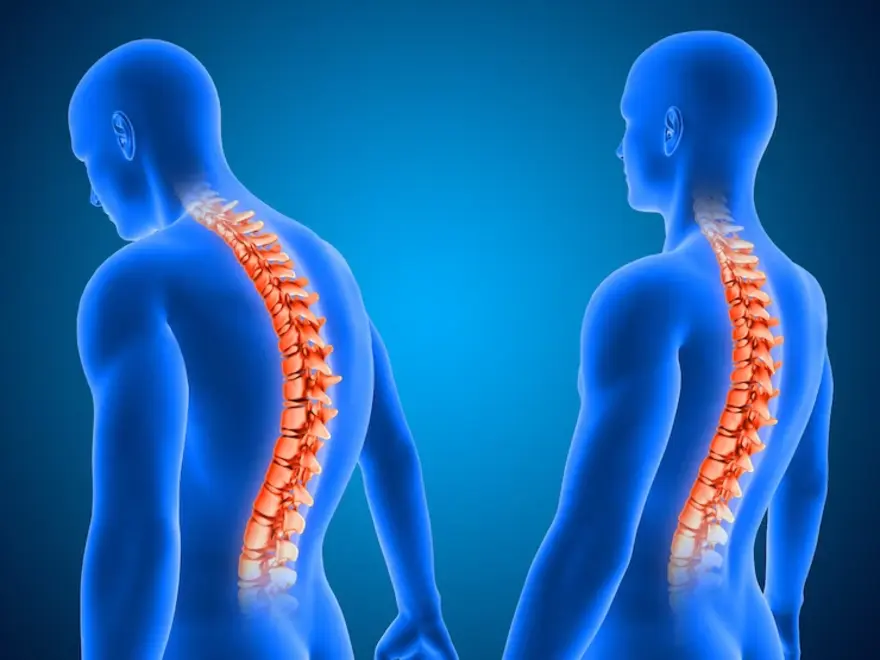
Kyphosis
Kyphosis is a spinal disorder that affects millions of people worldwide, yet many are unaware of its causes and consequences. Firstly, it’s important to understand that the spine naturally has curves to help distribute weight and maintain balance. However, when the upper back curves outward excessively, it leads to Kyphosis, often causing a visible hunchback and discomfort. In fact, this condition can range from mild to severe, impacting not only physical health but also emotional well-being. As a result, early diagnosis and treatment are crucial to prevent complications and improve quality of life.
What Is a Kyphosis ?
Causes of Kyphosis
Poor Posture and Lifestyle Factors
Aging and Osteoporosis
Scheuermann's Kyphosis
Symptoms of Kyphosis
Visible Postural Changes
Back Pain and Stiffness
Fatigue and Muscle Weakness
Breathing Difficulties
In severe cases of Kyphosis, the excessive curvature of the spine can compress the chest cavity, limiting the space available for the lungs to expand. As a result, individuals may experience shortness of breath or difficulty breathing, particularly during physical activity. This symptom is more common in advanced cases of Kyphosis, where the curvature exceeds 60 degrees.
Additionally, reduced lung capacity can lead to fatigue and decreased stamina, making it challenging to perform even simple tasks. For instance, climbing stairs or walking long distances may become exhausting. In extreme cases, severe Kyphosis can even affect heart function, as the compressed chest cavity may put pressure on the heart and surrounding blood vessels.
Digestive Issues
Emotional and Psychological Effects
Additionally, chronic pain and physical limitations can take a toll on mental health, leading to feelings of frustration, isolation, and helplessness. For instance, someone with severe Kyphosis may struggle to participate in social activities or maintain relationships due to their condition. Therefore, addressing the emotional and psychological aspects of Kyphosis is just as important as treating the physical symptoms.
Treatment of Kyphosis:
Treatment depends on the type of kyphosis, the severity of the curvature, the patient’s age, and symptoms.
1. Non-Surgical Treatments
- Physical Therapy: Exercises focused on strengthening the back and core muscles can improve posture and relieve pain. Stretching exercises help maintain flexibility.
- Bracing: For growing children or adolescents with Scheuermann’s kyphosis, wearing a brace may prevent the curve from worsening. The brace is typically worn until the child reaches skeletal maturity.
- Pain Management: Nonsteroidal anti-inflammatory drugs (NSAIDs), such as ibuprofen or naproxen, may be used to relieve pain and reduce inflammation.
- Osteoporosis Treatment: For age-related kyphosis, treating underlying osteoporosis with calcium supplements, vitamin D, and medications like bisphosphonates can help prevent further vertebral fractures.
2. Surgical Treatments
- Spinal Fusion: The most common surgery for kyphosis, it involves fusing two or more vertebrae together to straighten and stabilize the spine. Metal rods, screws, or bone grafts are often used to hold the vertebrae in the correct position as they heal and fuse together.
- Osteotomy: In some cases, part of the vertebrae may be removed or reshaped (an osteotomy) to reduce the kyphotic curve before spinal fusion.
- Vertebroplasty/Kyphoplasty: For fractures caused by osteoporosis, these minimally invasive procedures involve injecting bone cement into the fractured vertebrae to stabilize them and reduce pain.
